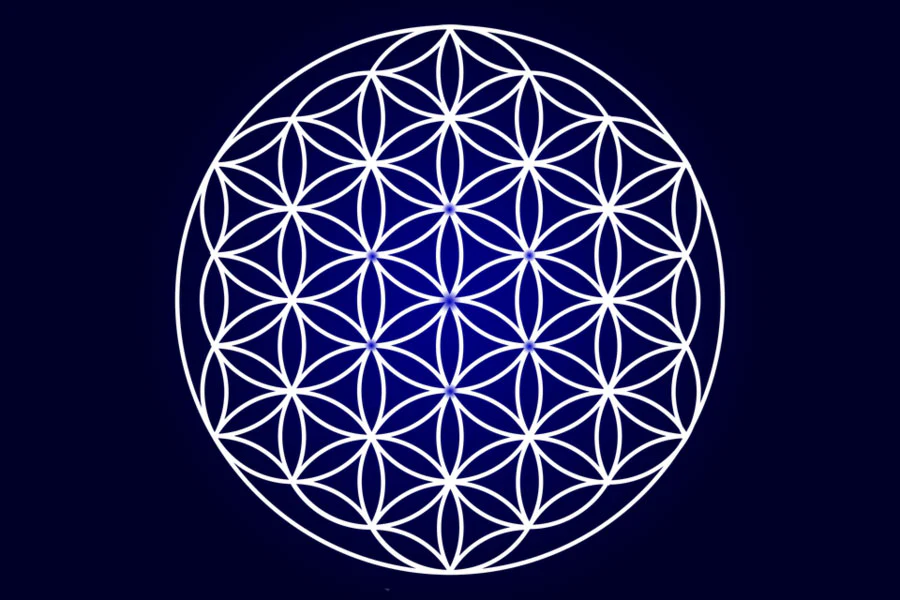
The Flower of Life is an ancient and captivating symbol, found in numerous cultures worldwide. It consists of overlapping circles arranged in a geometric pattern, forming a flower-like shape. This sacred geometry has fascinated artists, philosophers, and spiritual seekers for centuries. In this article, we’ll explore the meaning, significance, and history of the Flower of Life, providing you with a deeper understanding of its importance.
What is the Flower of Life?
At first glance, the flower appears as a simple design. However, its complexity goes far beyond its initial appearance. Essentially, it’s made up of several evenly spaced circles, usually arranged in a hexagonal pattern. The design begins with a single circle in the centre. Then, additional circles overlap, creating a flower shape. This pattern repeats, expanding outward with each circle added.
This symbol, moreover, represents unity, harmony, and the fundamental patterns of life. In many traditions, it is often linked to the creation of the universe, cosmic order, and spiritual awakening. Therefore, it holds great significance as a representation of the interconnectedness of all things.
The History of the Flower of Life
Interestingly, the flower is not a recent discovery. In fact, it has been present in ancient cultures across the globe. For instance, one of the most famous representations of the symbol can be found in the Temple of Osiris in Abydos, Egypt. There, the symbol is carved into the walls, highlighting its importance in ancient Egyptian culture.
Furthermore, the flower has also appeared in ancient Greek, Chinese, and Indian cultures. In Greece, it was closely associated with sacred geometry and the belief that geometric patterns form the foundation of all creation. Similarly, in Hinduism, it symbolizes the cycle of birth, life, death, and rebirth. Therefore, this symbol has transcended time and geography, leaving its mark on multiple cultures.
The Meaning Behind the Flower of Life
The flower holds significant spiritual and metaphysical meaning. Many believe that it represents the blueprint of creation, offering insight into the fundamental structures of the universe. It is often interpreted as a map of the universe’s energy, showing how everything is interconnected.
Additionally, in the field of sacred geometry, the flower is said to contain the building blocks of all life forms. Its intricate pattern reflects the underlying principles of nature and the laws that govern existence. As such, for those seeking spiritual growth, the flower can serve as a tool for meditation and self-awareness, helping one align with the natural rhythms of the universe.
Sacred Geometry
Sacred geometry is the study of geometric patterns and shapes that are believed to be the foundation of all existence. In this context, the flower plays a crucial role. It beautifully illustrates how patterns emerge from a single point of origin. In addition, it is connected to other important geometric shapes, such as the Seed of Life, Metatron’s Cube, and the Golden Ratio.
For example, the Seed of Life is a smaller formation within the design of the flower consisting of seven circles. This symbol is associated with creation, and it is often linked to the seven days of creation in various religious traditions. On the other hand, Metatron’s Cube, another pattern derived from the Flower of Life, is believed to contain the blueprint for the creation of the universe. These sacred geometric patterns are often used as tools for meditation, spiritual growth, and healing.
How to Use it for Personal Growth
The Flower of Life can be a powerful symbol for personal transformation. Its geometric beauty makes it an ideal focal point for meditation, helping to quiet the mind and enhance spiritual awareness. By visualizing the Flower of Life during meditation, you may begin to feel a deeper sense of connection.
Moreover, many people choose to wear jewellery featuring the symbol, believing it brings balance. Whether through meditation, art, or simply by being surrounded by this sacred symbol, the Flower of Life can be a meaningful addition to your journey of personal growth.
Conclusion
In conclusion, the Flower of Life is much more than just a beautiful geometric design. It symbolizes unity, creation, and the interconnectedness of all life. With its rich history across multiple cultures, it has continued to inspire those seeking deeper meaning. Whether you use it in meditation, explore it as a key symbol in sacred geometry, or simply appreciate its beauty, the Flower of Life remains a timeless symbol.
As you reflect on its deeper meaning, you may find that its intricate pattern speaks to you in ways words cannot express. Ultimately, the Flower of Life invites us to consider the beauty and interconnectedness of all existence, offering a deeper understanding of the universe and our place within it.

